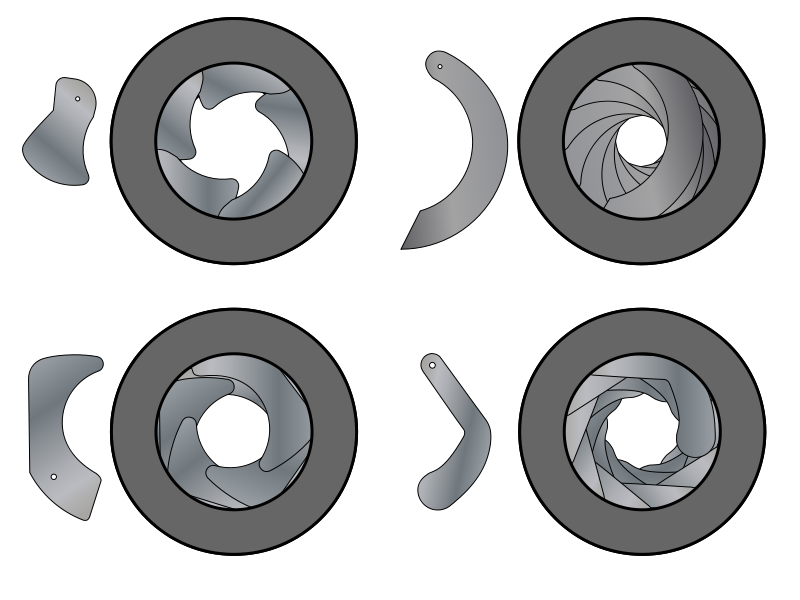Sommario
L'obiettivo - l'otturatore - il diaframma - indici di esposizione - mirino fotocamera - l'esposimetro - il telemetro - la pellicola - regola per una esposizione perfetta - La distanza iperfocale - La messa a fuoco all'infinito - Regole per utilizzare l'esposimetro analogico - Soggetti in movimento - La pellicola pancromatica - Fotografia con teleobiettivi - Consigli per la fotografia a colori - Misura dell'esposizione
- ITA -

(Image from https://it.wikipedia.org)
Il diaframma nella fotografia è essenziale per la buona riuscita di uno scatto, così come l'otturatore e l'obiettivo.
Il diaframma si trova, generalmente, all'interno dell'obiettivo ed è posto vicino all'otturatore. Generalmente, perchè in alcuni casi in cui l'obiettivo non esiste il diaframma è un sembplice foro da qui entra la luce che va verso l'otturatore e dunque sulla pellicola, un esempio molto pratico sono le fotocamere pinhole.
In tutti gli altri casi parliamo di un diaframma a lamelle, un numero variabile, disposte ad iride. Esse possono essere comandate tramite ghiera posta sull'obiettivo, variando, così, la loro apertura.
Proprio come l'occhio umano, l'iride di una fotocamera è capace di incamerare più o meno luce a seconda dell'esigenza e della situazione in cui ci troviamo.
La misura che ci consente di capire a quale livello di apertura ci troviamo, è indicata dalla lettera " f ".
Più i numeri relativi ad f aumentano e più l'apertura diminuisce, in caso contrario naturalmente l'apertura aumenterà.
Ciò, di conseguenza ci fa capire che ad apertura massima , la luminosità dell'obiettivo non cambierà mentre man mano che il diaframma viene chiuso, la luminosità diminuirà drasticamente.
I nuovi indici di luminosità che si andranno a creare saranno in proporzione della metà di quella precedente, viceversa quando si apre, gli indici saranno in proporzione il doppio di quella precedente.
La scala più in uso ed anche quella più nota è la seguente:
f/2 , f/2.8 , f/3.5 , f/5.6 , f/8 , f/11 , f/16 , f/22
Grazie a ciò che abbiamo descritto, possiamo affermare, dunque, che il diaframma è un elemento fondamentale per governare la "profondità di campo" di uno scatto.
Infatti, più l'apertura sarà piccola e tanto maggiore sarà la definizione dell'immagine su una particolare parte del soggetto inquadrato, cosa che non avverrà ad apertura massima dove la nitidezza si distribuirà su tutta la fotografia in maniera molto più lieve.
Dunque, otturatore e diaframma sono le due principali regolazioni che ogni fotografo deve conoscere.
Ad esempio se dobbiamo chiudere il diaframma per aumentare la nitidezza su di un volto o un'oggetto, allora dovremo compensare la luminosità aumentando i tempi d'esposizione dell'otturatore.
Se viceversa, vogliamo tempi molto brevi per catturare il volo di un uccello, allora dovremo compensare con un diaframma più ampio.
- ENG -

(Image from https://it.wikipedia.org)
The diaphragm is essential for the success of a photograph as well as the shutter and lens.
The diaphragm is generally inside the lens and is placed next to the shutter. Generally, because in some cases where the target does not exist the aperture is a hole sembplice from here enters the light that goes toward the shutter and thus on the film, a very practical example are pinhole cameras.
In all other cases, we speak of a diaphragm blade, a variable number, arranged iris. They can be controlled via ring placed on the lens, varying, thus, their opening.
Just like the human eye, the iris of a camera is able to rake in more or less light depending on the need and the situation in which we find ourselves.
The measure allows us to understand at what level of openness we are, is indicated by the letter "f".
More numbers related to f increases and decreases more than the opening, otherwise the opening naturally increase.
This in turn makes us understand that at the maximum aperture, the lens does not change while the brightness as the aperture is stopped down, the brightness will decrease dramatically.
The new indices of brightness that you are going to create will be in proportion to the half of the previous one, vice versa when it opens, the indexes will be in proportion to twice the previous one.
The scale no longer in use and also the best known is the following:
f / 2, f/2.8, f/3.5, f/5.6, f / 8, f/11, f/16, f/22
Thanks to what we have described, we can say, then, that the diaphragm is a fundamental element to govern the "depth of field" one more step.
Indeed, the more the opening will be small and the greater will be the definition of the image of a particular part of the targeted subject, something that does not happen to maximum opening where the sharpness will be distributed over the entire photograph in a much more mild.
Therefore, shutter speed and aperture are the two main adjustments that every photographer should know.
For example, if we have to close the aperture to increase the sharpness of a face or an object, then we will have to compensate for the brightness by increasing the exposure time of the shutter.
If, however, we want a very short time to catch the flight of a bird, then we will have to compensate with a wider aperture.









